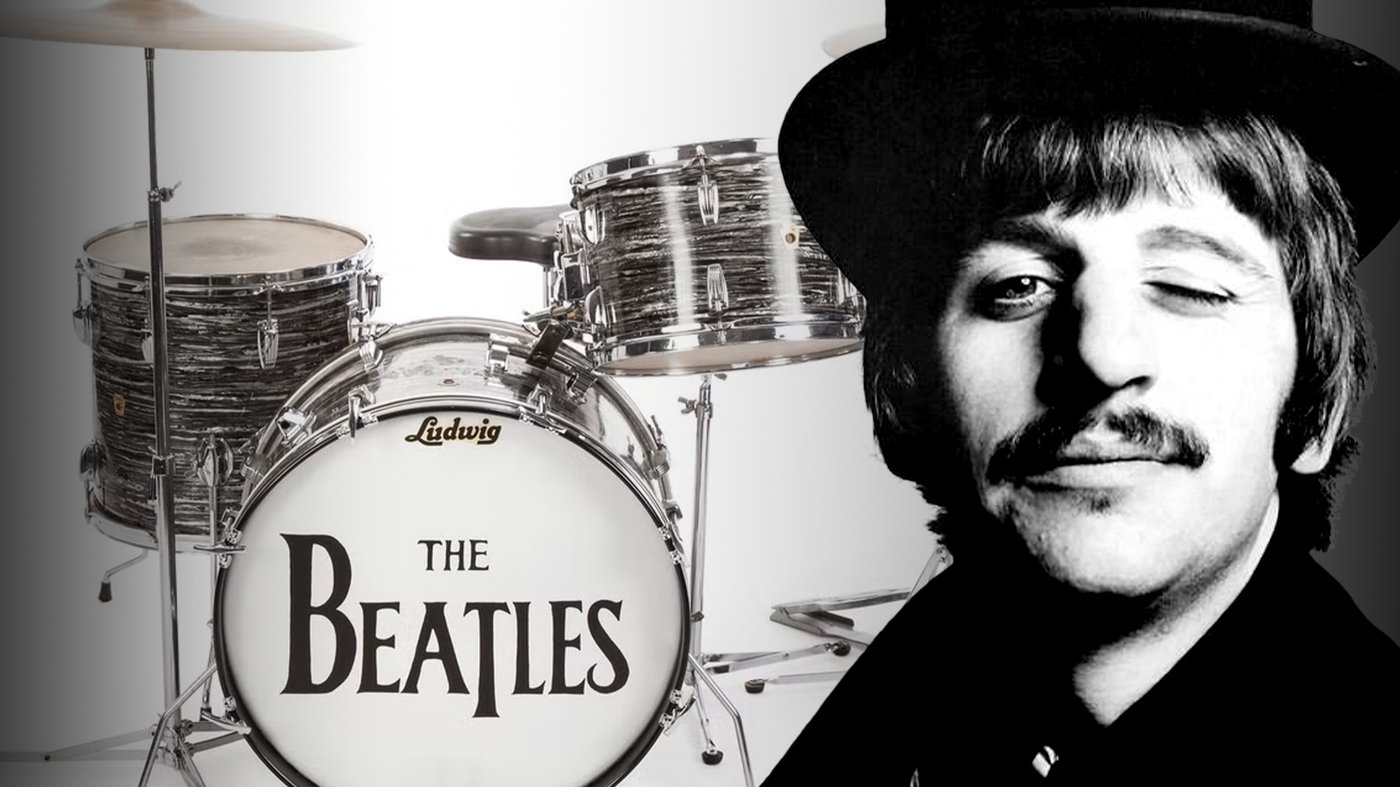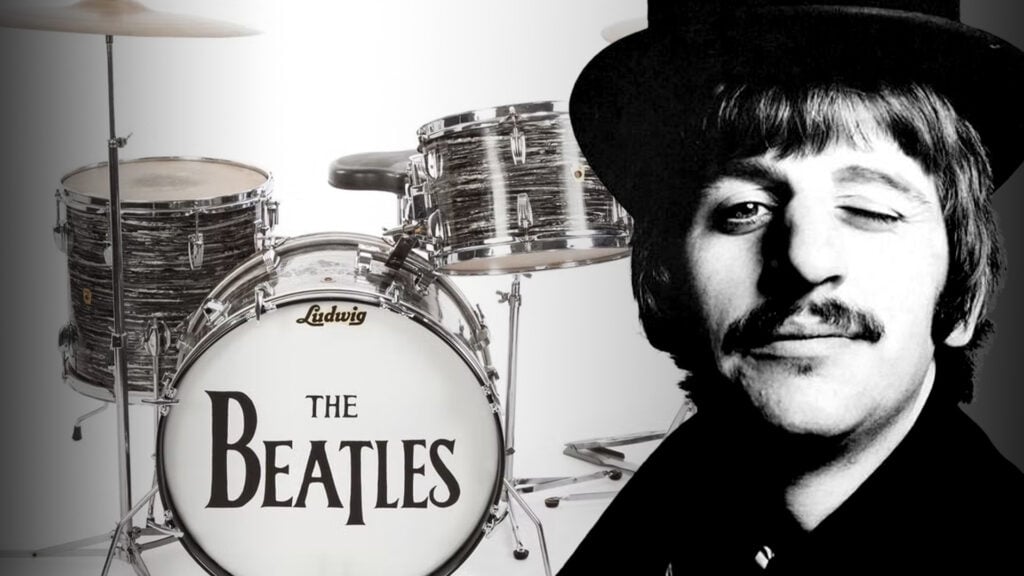/marketing/drumeo/membership/homepage/2025/anniversary/sticky-logo.webp)
Celebrate 13 years of Drumeo with
13 FREE bonuses 🥳 (worth $$1552.98)

Is Ringo Starr one of the greatest drummers of all time?
Or is he only famous because he was a member of The Beatles?
Even though he’s one of the most well-known drummers of the 20th century, fans of Ringo still think he’s underrated – especially because he’s had his fair share of haters:

In this article and video, we’re going to look at Ringo’s drumming – objectively – and explain why he’s such a great player.
Drummer, singer, songwriter, bandleader, rock ‘n’ roll pioneer…Ringo is responsible for making drumming look cool and inspiring countless people to take up the instrument.
Whether he was playing with The Beatles, the All-Starr Band or others, his one-of-a-kind approach set him apart from other drummers and he always wrote parts that elevated the song.
If you think Ringo shouldn’t be recognized as a groundbreaking musician because he doesn’t play impossibly technical parts, finish this page and then think again.

One reason Ringo has such a unique vice on the kit is – surprise, surprise – he’s a left-handed drummer who plays a right-handed setup. You can hear how he often uses his left hand to play accents and keep time on the hi-hat, and he executes his fills leading with his left.
Ringo has a unique way of hitting the drums. From his signature ‘windshield wiper’ hi-hat playing to ‘dancing’ and throwing his shoulder into the groove while he drums, the way he moves affects his feel and his swing.
He’s notable for his simplicity, unlike many drummers who are known for their technical prowess or speed. The Beatles’ music didn’t call for a showy drummer – they needed a drummer who could write the right parts.
Listen to the song “In My Life“. Where many drummers might’ve played an 8th note hi-hat groove, Ringo chose to hit the hi-hat just once per bar. That note placement makes all the difference.
“Love Me Do” is kick, snare, and hi-hat the entire song. Fills in “Let It Be” and “Hey Jude” don’t need to end with a crash, either.
Why hit a cymbal for the sake of it? Ringo decided it wouldn’t fit the music, so he simplified the part.
“It’s not the notes you play, it’s the notes you don’t play.”
Miles Davis
He knows how to serve the song on the drums, and this is one of the reasons Ringo Starr is one of the greats – and the perfect drummer for a band like The Beatles.
Without Ringo’s creativity and imagination, the Beatles wouldn’t have sounded as original. He created drum parts you wouldn’t typically hear in pop or rock songs in the ’60s and ’70s.
The tom and hi-hat part in the bridge of “Something“. The unconventional opening beat in “Come Together“. Who expected the drums to sound like this?
In the song “Ticket To Ride“, Ringo doesn’t play a metronomically perfect groove, and that’s part of the beauty of it.
Ringo’s signature style includes quarter note triplets (“Day Tripper”, “She Loves You”) and atypical drum solos like in “The End”, which features 8th notes on the bass drum, a broken 16th note fill on the toms, and an 8th note build in the final bar.
And for those thinking Ringo can’t hang with anything not in common time, listen to the proggy bridge of “Here Comes The Sun” (it alternates 5/4 and 4/4) or the bridge of “Happiness Is A Warm Gun” (9/8 and 10/8).

One of the world’s most recognizable drum parts is the main theme in “Come Together.” Ringo says he played it counterclockwise (starting on the floor tom) because he’s left-handed. However, if you check out the isolated track, it sounds like he’s descending from left to right. You be the judge.
Even the verse is special: most drummers might have opted for a backbeat, but Ringo chose to play 8th notes on the floor tom with quarter notes going on the kick. It takes a certain ability to get people dancing and grooving with such a simple part.
Ringo’s drumming on “Tomorrow Never Knows” and “While My Guitar Gently Weeps” is almost as recognizable to Beatles fans as “Come Together”.
A solo single he released in 1972 – “Back Off Boogaloo” – features a trademark snare pattern in the intro, a part that came to be because he claims he wasn’t able to play it on the bass drum under a groove.
In a sense, Ringo’s perceived shortcomings may have actually contributed to his strengths.


“I’m no good on the technical things…I’m your basic offbeat drummer with funny fills because I’m really left-handed playing a right-handed kit. I can’t roll around the drums because of that.”
Ringo Starr
Ringo’s fills are often original and memorable. That’s not to say he didn’t have his own formula for writing: he’d often play two 16th notes followed by a 16th note rest, and then a group of four or five 16th notes.
You can hear this structure in songs like:
The former Beatles drummer is also a fan of triplet fills (Listen to “Oh! Darling” and “A Day In The Life”), a proclivity shared by Ringo’s friend John Bonham.
While most reserve talk of legacy for people when they’re no longer with us, it’s clear Ringo has already had a massive impact on multiple generations of drummers (and drummer-adjacents).
His playing progressed as The Beatles progressed. Compare earlier tracks like “Twist and Shout” and “Please Please Me” to “Helter Skelter” and “I Want You (She’s So Heavy)” and you’ll notice a difference.
Many people are drawn to fast, technical playing for its physical and rhythmic impressiveness, but forget about the most important thing: music.
Ringo understands the role of the drummer and what it means to support the music.
And for that reason – outlined by the points above – he’s a genius in our books.
Gregg Bissonette has been playing ‘double drums’ with Ringo since 2003, and has been drumming in his All Starr Band since 2008. The former Beatle was one of Gregg’s earliest influences, and as he puts it, he now gets to play a few feet away from his drum hero every night.
Why does Gregg think Ringo has been such a game changer for so many drummers?
The Beatles wouldn’t sound the same
Songs like “I Feel Fine” or “Ticket To Ride” wouldn’t be the same without Ringo’s unique parts. The drums mirror the bass perfectly in “Come Together” and the main theme is immediately recognizable. The groove from “In My Life” only has one hi-hat hit per measure, yet it’s so effective that even drummers like Stan Lynch (Tom Petty And The Heartbreakers) have found inspiration there.
Ringo has his own style and swing
Many people started playing drums because of Ringo (and not just because he in one of the biggest bands in the world). Gregg changed from traditional grip to matched grip to emulate his hero. Ringo ‘dances’ while he plays, throwing his shoulder into it as he gets into a rocking motion.
He’s got a real swing to his style, which probably comes from his favorite drummers, like Cozy Cole. Even when the tune has a straight 8th note feel, Ringo tends to swing his fills (“Strawberry Fields”) which adds perfect unpredictability and feel to the song.
He changed the perception of drummers
You used to see artists like Elvis and Buddy Holly perform with the drummer in the background, generally unable to be seen by the audience. Suddenly, there was Ringo Starr up on a riser, just as important as John, Paul and George. They were a real band!
The drummer isn’t just keeping time in the shadows anymore; they’re counting the songs off, leading the way, and creating the feel.
Ringo also led the way in how drums were recorded. The compression on the drums and cymbals, the sound, the tuning…it was a real game-changer at the time.
He’s an incredible musician
Ringo and the band had such a great time, you’d never notice they didn’t record to a click. They always played as a unit, and Ringo listened carefully to the vocals. He never wanted a fill to get in the way of the song.
Even when he sings, he sings with the same great time and feel and swing. Plus, he brings joy to the music and makes it fun.
Whether or not you’re a fan of Ringo Starr or The Beatles, you have to admit it: he was ahead of the game as a drummer, and he has forever changed the landscape for beat keepers everywhere.
Brandon Toews is an author, educator, and performer based out of Vancouver, Canada. Brandon is the author of The Drummer's Toolbox, co-author of The Best Beginner Drum Book, and the Content Director at Musora, home to the award-winning online music education platforms Drumeo, Pianote, Guitareo and Singeo.


By signing up you’ll also receive our ongoing free lessons and special offers. Don’t worry, we value your privacy and you can unsubscribe at any time.
We use cookies for traffic data and advertising. Cookie Policy »